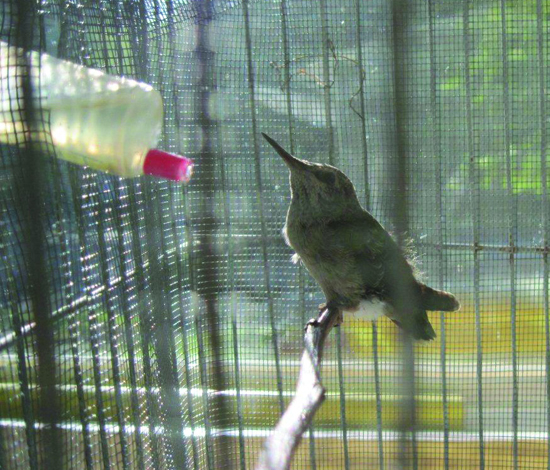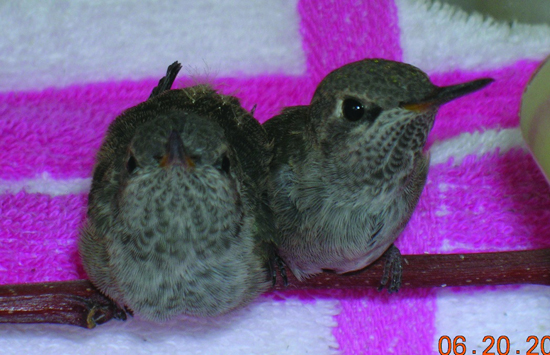 | | | Hummingbird in outdoor aviary Photos Cathy Dausman
| | | | | |
Imagine a bird's nest small as a hockey puck. It is made from feathers, lichen, fibers and spider webbing, which allows the nest to "grow" with its occupants. Imagine baby birds the size of kidney beans. Now imagine keeping those tiny, fragile beings alive by feeding them every 20 minutes, dawn to dusk, from a syringe with a needle smaller than angel hair pasta.
 That is the challenge one Lamorinda area volunteer has faced the past 24 years while raising Anna's hummingbirds from home. The hummingbird foster mom, who asked not to be named, says it is a "very big privilege" raising these spry little hyperactive birds, even with all the work it entails. It is something "anyone can do as long as they learn how to do it," she says. Fostering baby birds has opened up a new knowledge and awareness for her. But she warns that while adult hummingbirds may be a garden novelty and are certainly fascinating to watch, and the babies may look cute and sweet, they are not pets. That is the challenge one Lamorinda area volunteer has faced the past 24 years while raising Anna's hummingbirds from home. The hummingbird foster mom, who asked not to be named, says it is a "very big privilege" raising these spry little hyperactive birds, even with all the work it entails. It is something "anyone can do as long as they learn how to do it," she says. Fostering baby birds has opened up a new knowledge and awareness for her. But she warns that while adult hummingbirds may be a garden novelty and are certainly fascinating to watch, and the babies may look cute and sweet, they are not pets.
 Keeping native wildlife is against the law without a Department of Fish and Game permit. Lindsay Wildlife Museum keeps the permit; its animal foster parents do the work. Each bird is numbered and dated upon receipt, and each has a different personality. The tiniest babies nest on a heating pad. Feeding them sometimes involves crushing fruit flies and doling out specialized food and medicine. Slightly older birds, or fledges, are placed inside a bird cage draped with window screen mesh to prevent their fragile wings from being damaged when they brush the cage bars. Older, stronger birds are transferred to a standard 4 x 4 x 8 outdoor aviary. Keeping native wildlife is against the law without a Department of Fish and Game permit. Lindsay Wildlife Museum keeps the permit; its animal foster parents do the work. Each bird is numbered and dated upon receipt, and each has a different personality. The tiniest babies nest on a heating pad. Feeding them sometimes involves crushing fruit flies and doling out specialized food and medicine. Slightly older birds, or fledges, are placed inside a bird cage draped with window screen mesh to prevent their fragile wings from being damaged when they brush the cage bars. Older, stronger birds are transferred to a standard 4 x 4 x 8 outdoor aviary.
 After a week in the cage, flying ever faster and more furiously, they are finally released. For us Lamorindans, that means Anna's hummingbirds will be found in our gardens. If you happen upon a grounded bird, don't play with it, feed it or give it water. And leave it alone if it's not in obvious danger. After a week in the cage, flying ever faster and more furiously, they are finally released. For us Lamorindans, that means Anna's hummingbirds will be found in our gardens. If you happen upon a grounded bird, don't play with it, feed it or give it water. And leave it alone if it's not in obvious danger.
 To learn how to become a Lindsay Wildlife Museum volunteer, attend the next free orientation August 11 from 3 to 4:30 p.m. at 1931 First Avenue, Walnut Creek or visit wildlifemuseum.org/getinvolved/. To learn how to become a Lindsay Wildlife Museum volunteer, attend the next free orientation August 11 from 3 to 4:30 p.m. at 1931 First Avenue, Walnut Creek or visit wildlifemuseum.org/getinvolved/. |


